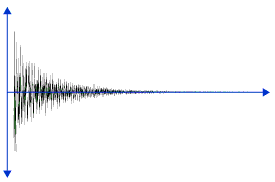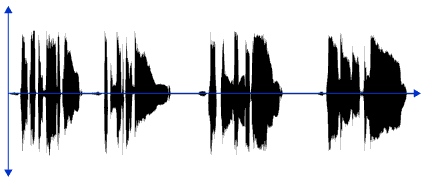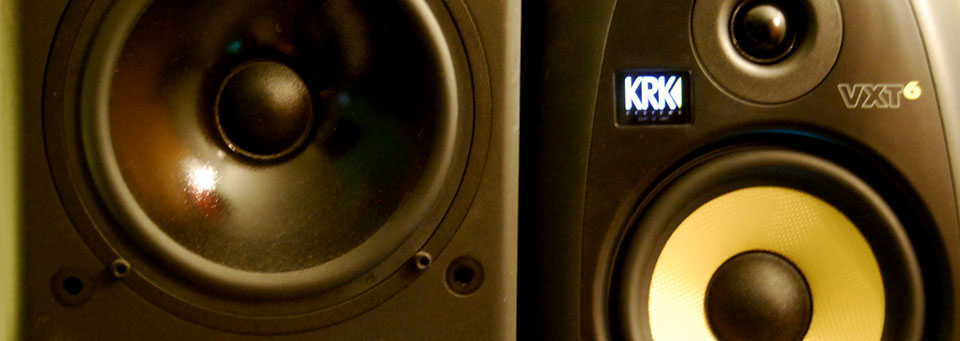Now, click to watch our video at our sister site (or read on) ..
So, if the soundwave energy is not a 'thing' in itself, how is it manifested? Because most of the sound we hear arrives at our ears through the air, it is most useful to study the theory of air pressure soundwaves.
Air molecules
The air that surrounds us is comprised of particles known as air molecules. It is not important to understand what these molecules are made of.
Air pressure
Air pressure is a measure of how tightly packed together the air molecules are, in other words, the air density. When a sound is created, the surrounding air pressure is temporarily disturbed.
"Normal atmospheric pressure" depends on altitude. The higher you move through the atmosphere the less air molecules, the lower the density and therefore the lower the "normal" air pressure.
In sound theory, changes to air pressure are measured in units called decibels. This is the amplitude, volume, or loudness, of the sound.
Source
Sound is produced when an object vibrates and disturbs the pressure of the surrounding air. Such an object is called the source. The source may be a vocal chord, a guitar string, car engine or anything that makes a sound.
Vibration
As a model to aid understanding, it is helpful to define vibration as the repetitive expansion and contraction of the source. A cycle of vibration works like this ...
- Source starts at original size
- Source expands (gets bigger)
- Source reaches maximum size (bigger than normal)
- Source contracts (gets smaller)
- Source returns to original size
- Source contracts (gets smaller)
- Source reaches minimum size (smaller than normal)
- Source expands (gets bigger)
- Source returns to original size
Cycle of source (a sphere) vibration - compression and rarefaction

Edited screenshots from a the Logic sample editor window (amplitude and time axis have been added)
1) A single snare hit

2) A vocal recording (2 bars)

Compression
As the source expands it pushes the surrounding air molecules away causing them to "bunch" together and the air pressure to increase.
Rarefaction
As the source contracts the surrounding air molecules spreads out to fill the increasing space, causing a decrease in air pressure.
Cycle of a loudspeaker
Another good model for understanding the cycle of a sound wave is provided by the movement of a loudspeaker cone. Click below for a useful diagram.
![]() Loudspeakers, the inner ear and waveform diagrams
Loudspeakers, the inner ear and waveform diagrams
Sound waves
As the source expands and contracts a pattern of changing air pressure energy moves away from the source. This pattern of energy is called a sound wave. Sound radiates out in all directions from a sound source.
It is important to understand that individual air molecules do not move from the source to the listeners ear but move (or vibrate) back and forth around a fixed point knocking against each other thereby transferring the changing air pressure energy.
Imagine yourself standing in the middle of a dense crowd. You push the people next to you away. They push the people next to them before rocking back towards you. The people they push push other people and so on. A wave of energy can be said to have passed through all the people surrounding you, started by you. This process is not unlike a Mexican wave.
Human perception
When this pattern of changing air pressure reaches the ear it moves through a series of "chambers" before reaching the inner ear. Here it encounters a line of tiny hair receptors. Put simply, these hairs are pushed one way by air pressure above normal atmospheric pressure (compression) and the opposite way by air pressure below normal atmospheric pressure (rarefaction). When there is no pressure change they remain stationary. The movement of these hairs causes an "electrical" signal to be sent to the brain which we perceive as sound.
If you haven't done so already, see the video and digrams here... Loudspeakers, the inner ear and waveform diagrams
Speed of sound
An article and video on the speed of sound is here
Why soundwaves diminish (lose energy)
As it travels, a sound wave's energy is slowly lost as heat, through friction. Because a gas, such as the air, presents less friction to a sound wave than a solid, it can travel a longer distance before all it's energy is lost. A solid, on the other hand, will quickly absorb the sound wave, turning its energy into heat, and preventing it from travelling as far.
It's important to recognise that although sound travels faster through a solid object, such as a brick wall, it's energy is quickly absorbed and it will either emerge on the other side quieter or duller or not at all.
The distance that a sound wave can travel through solid objects depends on the nature of the object, and the sound wave's frequency. Here are some simple rules ..
- if the object is wider than the sound wave's wavelength, the sound wave will be absorbed. This explains why hi-frequency sounds are easily stopped.
- if the object is narrower than the sound wave's wavelength, the sound wave will pass through, but with diminished amplitude. This explains why low frequency sound are hard to contain.
- if the sound wave is a complex wave containing both low and hi frequency harmonics, each harmonic will be affected differently. This explains why we only hear bass frequencies through a door or wall.
Now read on ...
Our Waveform diagrams article explains essential soundwave theory such as amplitude, frequency and wavelength.

